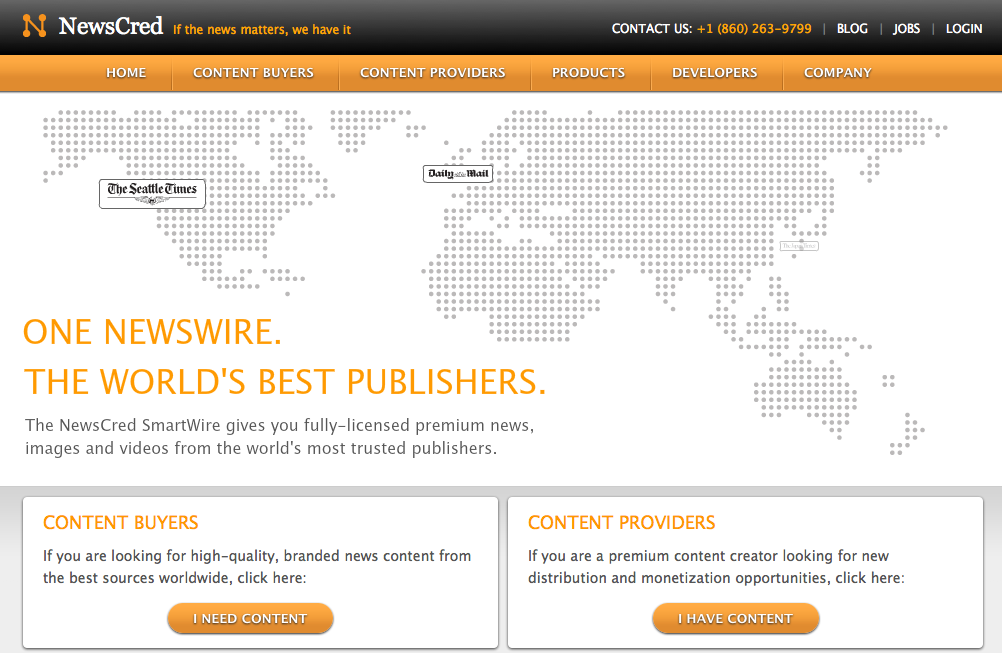Startups pivot; it’s part of the process. But how many startups pivot multiple times and still manage to raise significant cash from reputable investors? Sure, maybe it’s a sign of a bubble, a sign that startups are indeed overfunded, or maybe this company is just getting better with each successive effort.
We first covered NewsCred back in 2008, when they launched a credibility rating score for publishers, authors, and stories (by way of community voting plus algorithms) in an attempt to help readers filter the noise and find the highest quality news.
Early last year, NewsCred relaunched as a “Ning for newspapers”, allowing users to build custom online newspapers in minutes. Both approaches seemed to hold water, and the startup raised $750K in seed funding from FLOODGATE and IA Ventures last September in support of it new look.
However, neither model quite caught on, and the NewsCred of today has landed somewhere in the middle. Co-founder and CEO Shafqat Islam says that two years of iterating and nail-biting has led to the team deciding to ditch its consumer site, reprioritizing its focus on the simple (if not ambitious) goal of reinventing the concept of a newswire service.
To do so, NewsCred is licensing content from more than 700 premium media brands, like Bloomberg, Forbes, Guardian, WashPo, and The Economist, and charging customers to access its news API — and the premium content from those publishers.
Hopefully, the third try is the charm. And, hey, quite a few reputable investors are willing to bet that it will be. Today, the startup announced that it has landed $4 million in series A funding led by FirstMark, with participation from Lerer Ventures, AOL Ventures and Advancit Capital, through Shari Redstone. (FLOODGATE and IA Ventures also reinvested.)
It’s a vote of confidence for the startup’s mission to reinvent the newswire and, in so doing, connect audiences with “the world’s best journalism”, says Islam. In its new B2B approach, NewsCred is looking to provide publishers and brands with fully licensed, full-text articles, photos, and videos from international newspapers to blogs and indy rags. The startup’s in-house editorial team filters and curates thousands of articles for each of its clients’ specific needs and interests, whether broad or niche. Through one platform, one license, and one bill, NewsCred is endeavoring to make it a breeze for publishers and brands to buy, manage, and increase revenue.
Along with its editorial team, the startup uses its API to filter and customize news articles by topic, location, language, sources, and date. Through its proprietary semantic and natural language processing technology, NewsCred curates 215K full-text articles from 700+ sources across 50 countries, in eight languages, all of which is organized into 20 categories, and 47K topics.
Islam says that the startup’s tech is platform agnostic, working on tablets, mobile, the Web, Facebook, etc and delivers content, images, and multimedia in XML, RSS, or JSON.
As to its revenue model? NewsCred chages a monthly API licensing fee to access its content, which is based on the volume of news stories as well as the sources licensed. All revenue received by the startup is then shared with content providers, and the CEO says that it is already paying some of its sources six-figures.
For journalists, this can be a great way to gain exposure and access to new distribution channels, while maintaining attribution, and grabbing a supplemental paycheck. For publishers looking to up their production to keep up with the content-spewing 24-hour digital news cycle, NewsCred’s access to a huge array of voices and its ability to customize content and create targeted editorial sections for niche audiences — along with the complementary advertising opportunities — could be appealing. Especially for publishers already pulling in a high volume of pageviews.
It’s true that consumers want access to a variety of competing views when consuming their digital content, and NewsCred certainly gives content providers and brands an opportunity to access quality journalism and provide their readers with just that, but news consumers are also wary of plain old RSS feeds, aggregators, rebloggers, syndicators, and the ilk. NewsCred can sidestep this with a big editorial team and feverish curation, but it could be a slippery slope.
A one-stop platform for publishers and content producers to gain supplemental content and revenue streams is no doubt appealing, and may just be where this is all going. As long as it doesn’t require another pivot. For more, check ’em out at home here.
What do you think? Is NewsCred onto something?

